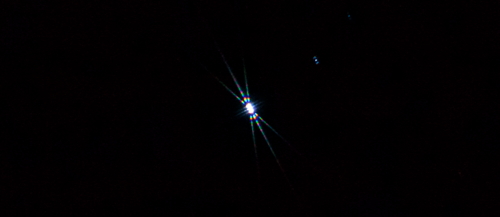Donated LightBridge Dob First Light;
Imaging Crab Nebula, Flame and Horsehead Nebulae
Posted: 16 January 2015
During the day on Thursday, 15 January 2015, I assembled a 10" f/5 LightBridge Dobsonian telescope that has been donated to Oracle State Park by Meade Instruments in recognition of the Park being selected by the International Dark-Sky Association as an "International Dark Sky Park".
|
Open: Thursday, 15 January 2015, 1814 MST Temperature: 56°F |
Session: 768 Conditions: Clear, some clouds low in south, breezy |
I set up the 10" LightBridge on the observatory patio:

The first task was to align the red-dot finder to the telescope. That was actually more of a challenge than I expected. The finder azimuth and elevation did not have enough travel to allow it to be precisely aligned. Got close though. The second surprise I got was that the supplied 2" 26mm eyepiece would not reach focus when fully inserted. Sliding the eyepiece slightly out from the eyepiece holder did allow focusing. I did not test any other eyepieces with the Dob. Optical collimation was good and had not shifted during shipment. Viewed M42 (Great Orion Nebula); very nice view of the entire nebula. The Trapezium stars were easily separated at 48X and were very sharp (as were all stars). Comet C/2014 Q2 (Lovejoy) was still a naked eye object high in the sky. It was a difficult object to see through the lens of the red-dot finder but I got it. In the 10" f/5 telescope the view of the comet was impressive. The nucleus was a bright star-like object and the coma was very large and bright.
1922 MST: Zodiacal Light was very bright in the western sky and visible almost to the central meridian. I next viewed the Double Cluster in the LightBridge. It was a gorgeous view, with both clusters well inside the field-of-view (FOV). Went back to Orion and viewed the Flame Nebula. It was easily seen. The Horsehead Nebula was almost visible; nearby nebulosity was visible. Orion was not yet high enough in the sky for a good Horsehead viewing attempt. I declared this donated telescope operational. Thanks Meade!
1936 MST: returned to using the 8" LX200-ACF in the observatory. Viewed M1 (Crab Nebula), 83X. Good view. Began setting up to image it with the D7000 DSLR. Added a f/6.3 focal reducer and mounted the DSLR at prime focus using the off-axis guider (OAG). After doing a focus test on the star Aldebaran using the 8" Bahtinov Mask, I imaged M1. This is a guided 10 minutes, ISO 5000, exposure:

The stars on the image are slightly elongated, apparently due to a mounting problem and not poor guiding as other OAG-mounted images this night showed the same elongation. I'll have to watch for that on future OAG images.
2033 MST: slewed to Rigel and mounted the D7000 DSLR with 300mm lens piggyback on the 8" telescope. Screwed on a Bahtinov Mask to the camera lens. (If you haven't read my review of the Gerd Neumann Bahtinov Mask for Camera Lens, please do.) I did a focus test on Rigel, seen here cropped from the full-frame image:

This is a cropped image of the Flame Nebula and the Horsehead Nebula (and a faint satellite), guided 5 minutes, ISO 6400:

2103 MST: ended imaging. Returned to the 10" Dob. Now that Orion was higher in the sky I made another attempt to view the Horsehead Nebula. The Flame Nebula and the nebulosity by the Horsehead were visible, but no Horsehead visible this night. I have seen it in the past with my 8" LX200-ACF from Cassiopeia Observatory so I know it can be viewed. The last object viewed with the Dob was Jupiter. Good view of the planet and the four Galilean Moons.
Then began closing up. I wanted to stay longer but couldn't due to an early morning meeting the next day in support of Oracle State Park.
|
Close: Thursday, 15 January 2015, 2136 MST Temperature: 47°F |
|
Comments are welcome using Email. If you are on Twitter you can use the button below to tweet this report to your followers. Thanks.
Cassiopeia Observatory Home Page
Copyright ©2015 Michael L. Weasner / mweasner@me.com
URL = http://www.weasner.com/co/Reports/2015/01/16/index.html
